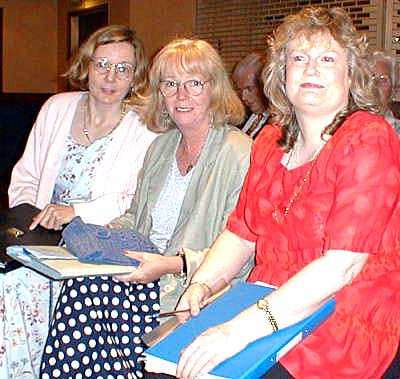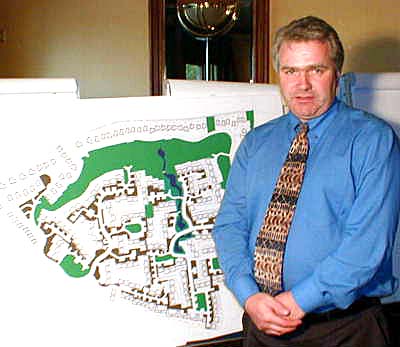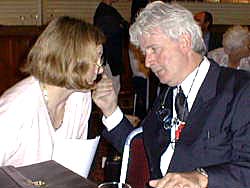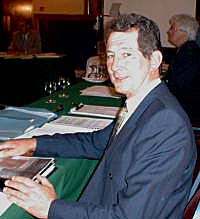
AMBASSADOR HOTEL, KILL, 20 July 1999: by Brian Byrne & Trish Whelan. The An Bord Pleanala oral hearing on the controversial proposed 416-house development in Ballymore Eustace heard today that it would become ‘a self-contained ghetto’ on the outskirts of a village that would be ‘incapable of absorbing it’. That was the view expressed by Allan Dukes TD (FG) who told the hearing that the Abbeydrive Developments project was of a size and density ‘totally out of keeping’ with a village like Ballymore. (Pictured above at the appeal are Ballymore activists Catherine Smith, Rosemary Martin and Rose O'Donoghue.)
Earlier, the managing partner of the architectural group Architectural Design and Project Management, Diarmuid Herlihy, told the hearing that the original application for 507 houses had been changed to one for 416 after Kildare County Council had asked for further information. In addition, the developers had included provision for a Montessori School, a health centre and a small shopping development after consultation with the parish priest.
Kildare County Council has granted permission for the development, but the appeal to ABP has been taken by ABCD, the lobby of local people incensed at the proposal.
During the morning session, Cllr Timmy Conway (PD) outlined the objections of a group of members of Kildare County Council who are supporting the objections. Cllr Conway said that in the original rezoning for the site it had been the councillors’ intention that it be for a density of one house per acre, and he said that in no way could the proposed density (at 6.8 houses per acre) be catered for in Ballymore.
Similar opposition was given by Emmet Stagg TD (LAB) who said it represented the supplanting of ‘a chunk of Dublin’s population’ on the indigenous people. “I live in Straffan, which is the only other village in Kildare not yet invaded by people from our neighbouring counties, and we’re now feeling very threatened in the light of what happened to Ballymore,” he said.
Cllr Mary Glennon (I) said that providing a Montessori School that would cost £275 a month for each child was not going to solve the problems already being experienced by school and other facilities in the village. She said Ballymore was ‘under siege’, with its small school already ‘straining at the seams’. “Small communities like this need to be protected,” she added. “Every community needs new blood, but Ballymore has to be allowed to develop slowly.”
Jack Wall TD (LAB) said he hoped that ‘common sense would prevail’, otherwise Ballymore will suffer from ‘developing before its time’. “It must be allowed to develop at a village rate rather than a town rate,” he said.
Consultant planner Michael O’Neill for ABCD said his clients had been ‘incensed’ at how they had been treated so far by the planning system. “Ballymore must be considered to be a ‘rural hamlet’ and insulated from urban development,” he told the hearing, and then went on to note that the developers had provided a ‘carrot’ in a sewerage treatment plant. “The proposed development would be unintegrated and unsustainable and if town planning is to have any credibility the plant must be rejected and seen for what it is - a Trojan Horse out of whose belly 1,500 people will jump into Ballymore.”
Members of ABCD also gave presentations. John White said the people of the village had been ‘sadly let down’ by a lack of consultation with them in the planning process. Marie O’Neill took issue with several aspects of the Traffic Impact Survey furnished with the proposal and noted that gardai in Blessington had provided accident figures which showed even the existing and growing traffic levels were resulting in increased accidents. She also noted that the only link with the town from the area of the proposed development was a bridge over the Liffey which was ‘already dangerous’ but whose character as the ‘focal point’ of the village had to be maintained.
The hearing continues this afternoon, under the direction of ABP inspector Ben Cranwell. The developers are represented by barrister Eamon Galligan and Frank L Benson, while Kildare County Council is represented by a team under the direction of Mike Kenny, temporary senior executive planner.
Ballymore development 'should be refused' - DTO
AMBASSADOR HOTEL, KILL, 21 July 1999: by Brian Byrne & Trish Whelan. The proposal by Abbeydrive Developments to build a 416-house development at Ballymore Eustace should be refused, according to the Dublin Transportation Office. At yesterday’s oral hearing by an Bord Pleanala on proposal, planning officer Noel Sheridan of the DTO said that it did not fit with the Strategic Planning Guidelines view that developments outside certain designated growth centres, such as the Naas-Newbridge-Kilcullen triangle, should ‘be strictly devoted to local needs’, in order to meet the Dublin Transport Initiative’s goal of cutting down on the use of car travel into the Dublin Metropolitan Area. “The current proposal by Abbeydrive is not related to local needs, and would turn the village into a commuter town,” he said.
 In response to questions from barrister Eamon Galligan (pictured here on right with Newbridge solicitor John Reidy) and consultant Frank L Benson for the developers, Mr Sheridan said he had not formally assessed the proportion of any traffic from the proposed development which might go to Dublin. “But we are stating that it would be significant,” he said. Mr Galligan put it to him that he had given evidence to the hearing without having done the necessary research of establishing traffic flows, and suggested that in fact the development would provide homes for people working in the designated growth area of Naas-Newbridge-Kilcullen.
In response to questions from barrister Eamon Galligan (pictured here on right with Newbridge solicitor John Reidy) and consultant Frank L Benson for the developers, Mr Sheridan said he had not formally assessed the proportion of any traffic from the proposed development which might go to Dublin. “But we are stating that it would be significant,” he said. Mr Galligan put it to him that he had given evidence to the hearing without having done the necessary research of establishing traffic flows, and suggested that in fact the development would provide homes for people working in the designated growth area of Naas-Newbridge-Kilcullen.
The hearing continues this morning under the direction of ABP inspector Ben Cranwell.
Details of Ballymore housing development given at hearing

AMBASSADOR HOTEL, KILL, 22 July 1999: by Trish Whelan & Brian Byrne. The Abbeydrive Developments plan which is subject to an oral hearing by An Bord Pleanal this week consists a scheme of mixed houses built on a 62.5-acre site. Project architect Diarmuid Herlihy detailed how the scheme would include water features of streams and lakes. (Abbeydrive principal Gerry Deane is pictured above with a plan of the project.)
Mr Herlihy told the hearing that the original scheme had included provision for the building of social housing by the developer. “But subsequently Kildare County Council expressed a wish to purchase that particular property and develop the 26 houses themselves,” he said, adding that after consultation with the planners and at a public meeting, provision had been made for community facilities on the site, including a Library, a Montessori School, a social services centre, health clinic and some shop units. These, he said, are currently subject to a separate planning application.
The development was based what Mr Herlihy called ‘The Cheshire Design Guidelines’ which adopted the cul-de-sac principle to reduce through traffic and produce internal small communities. “In excess of 30% of the development will be open space, a much greater proportion than normal,” he said, adding that three-quarters of an acres in total would be devoted to water features. “The proposal will fit very comfortably into the framework of Ballymore Eustace, the clusters of houses reflecting the rural ambience.”
He noted that a series of courtyards through the development will allow parents to keep an eye on their children at play, and there would be pedestrian access from one cul de sac to another.
There 'will be development' in Ballymore - planner
 AMBASSADOR HOTEL, KILL, 22 July 1999: by Trish Whelan & Brian Byrne. No village or town in Ireland is set in the 60s or 70s, Kildare’s temporary senior executive planning officer told the An Bord Pleanala oral hearing on a controversial Ballymore Eustace housing development yesterday. “There has to be development, or else we will get closed, shuttered or deserted villages as are seen in France,” Michael Kenny said.
AMBASSADOR HOTEL, KILL, 22 July 1999: by Trish Whelan & Brian Byrne. No village or town in Ireland is set in the 60s or 70s, Kildare’s temporary senior executive planning officer told the An Bord Pleanala oral hearing on a controversial Ballymore Eustace housing development yesterday. “There has to be development, or else we will get closed, shuttered or deserted villages as are seen in France,” Michael Kenny said.
He was responding to a question from consultant town planner Michael O’Neill, representing ABCD, the residents group appealing the Abbeydrive Developments permission to build 360 houses close to the village. Mr O’Neill had asked was there any strategic reason why Ballymore should develop. Mr Kenny said there WILL be development in Ballymore, but at the moment they were looking at one particular development which was ‘a substantial chunk all at one time’.
Earlier, Mr Kenny had told the hearing that while the council had set policy for growth in various towns and villages, there was room ‘within an envelope’ for further growth on undeveloped land in Ballymore. “For landowners within that envelope there must be a level of hope that they would get development for that land, for whatever uses they feel will run.”
Commenting on previous references from the promoter’s side which suggested that Johnstown, Kilcullen, Sallins and Ballymore were similar, Mr Kenny said Ballymore was significantly different from these. “Johnstown, for instance, is adjacent to one of the premier roads in the country,” he said, adding that Sallins had seen much development based on its proximity to a major road and railway and the existence of a large number of local authority houses.
Much of the discussion during the questioning of the Kildare County Council group at the hearing centred around which development plans were involved in the processing of the original application, which was granted in January of this year with the proviso that only 360 houses be built over a seven-year period. A significant amount of the developers’ input referred to the 1999 County Development Plan. Mr Kenny said that the 1996 town development plan for Ballymore was the ‘primary one’ used at the time, as the 1999 County Development Plan had not yet been adopted.
However, during the summing up, Mr Kenny pointed out that the developers appeared to have misinterpreted an element of the 1999 County Development Plan, which they had read as zoning for ‘urban development’. This was not the case, he said.
Only half of Ballymore development traffic for Dublin - expert
BALLYMORE EUSTACE, 23 July 1999: by Trish Whelan & Brian Byrne. Only half of the traffic from the proposed Abbeydrive Developments scheme in Ballymore Eustace would be commuters to Dublin, a traffic expert told this week’s oral hearing by An Bord Pleanala - the Planning Appeals Board - on the company’s plan to build 416 houses in the village.
 Graham Delal, giving evidence for the developers, was rebutting a suggestion by consultant planner for the local ABCD residents lobby Michael O’Neill (pictured above in conference with his clients) that over 70% of the car traffic generated by the development would be Dublin-bound, and thus would add to congestion in the Dublin Metropolitan Area.
Graham Delal, giving evidence for the developers, was rebutting a suggestion by consultant planner for the local ABCD residents lobby Michael O’Neill (pictured above in conference with his clients) that over 70% of the car traffic generated by the development would be Dublin-bound, and thus would add to congestion in the Dublin Metropolitan Area.
He also rejected suggestions that accidents already occurring in the area were related to traffic to and from Ballymore Eustace, saying there was ‘no hard evidence’ produced by the objectors that any of the accidents they claimed were happening ‘related to traffic in or out of Ballymore’. He added that the area which most of the accident concentration appeared to be on was the Hollywood Cross, no arm of which went to directly to Ballymore
On further questioning from Mr O’Neill, he admitted that he had not sought the accident information in the preparation of his submission, nor had he conducted an origin/destination survey of existing traffic in the village.
Sewerage plans could 'destroy' Liffey near Ballymore - claim
 BALLYMORE EUSTACE, 23 July 1999: by Trish Whelan & Brian Byrne. The proposed 416-house scheme by Abbeydrive Developments in Ballymore Eustace has the capacity to ‘wipe out the Liffey’ in the area as a fishery and an amenity, Tom Deegan of the Ballymore Eustace Trout & Salmon Anglers Association said in his submission to the An Bord Pleanala hearing on the project. He was objecting both to the housing development itself and the proposed sewerage treatment plant that the developers intend to build in conjunction with Kildare County Council.
BALLYMORE EUSTACE, 23 July 1999: by Trish Whelan & Brian Byrne. The proposed 416-house scheme by Abbeydrive Developments in Ballymore Eustace has the capacity to ‘wipe out the Liffey’ in the area as a fishery and an amenity, Tom Deegan of the Ballymore Eustace Trout & Salmon Anglers Association said in his submission to the An Bord Pleanala hearing on the project. He was objecting both to the housing development itself and the proposed sewerage treatment plant that the developers intend to build in conjunction with Kildare County Council.
“At the end of the day, neither Kildare County Council nor Abbeydrive can guarantee a minimum dilution of the sewerage effluent form the proposed development,” he said. “The EIS accompanying the proposed development states that it will ‘significantly increase the foul discharge’ from the site. Without the guaranteed dilution, this development will pose a significant threat. Also, the document makes no mention of the ongoing effect that the phosphate discharge from the proposed 416 extra houses will have on the water quality of the River Liffey. We believe it will lead to enrichment and consequent deterioration of the water quality.”
He based his claim on the fact that Ballymore is unique on the River Liffey in that if no compensation water is released, then no dilution of the sewerage effluent can be achieved. “All other towns and villages have the benefit of stream and river tributaries giving some measure of dilution.”
In his evidence he noted that the ESB and Dublin Corporation are the only bodies who can control the level of water in the River Liffey below the Poulaphuca Reservoir. “The Liffey Reservoir Act 1936 is strong on protecting the water impounded in the reservoir for public water use,” he said. “It has little to do with protecting the river downstream of the reservoir as a fishery or an amenity.”